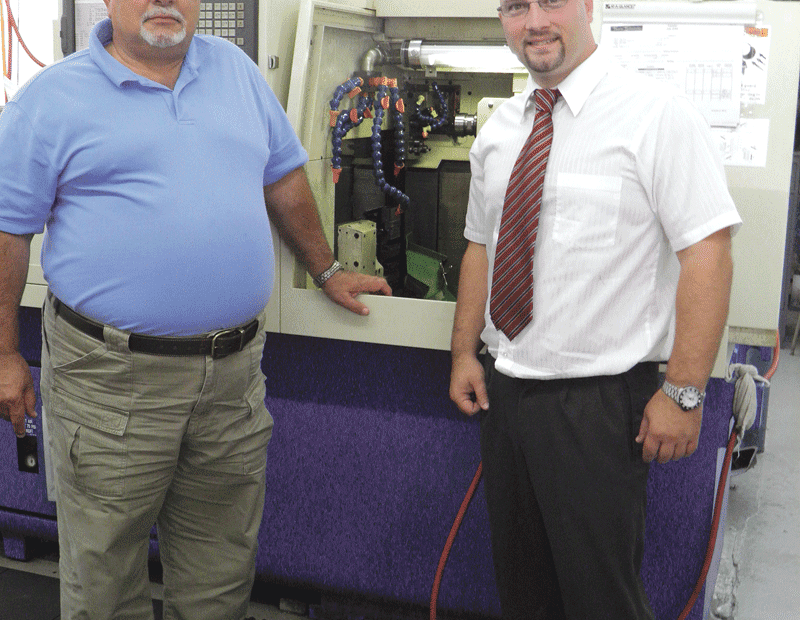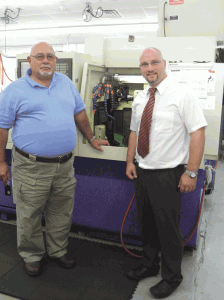
On the Cutting Edge
Company Makes Medical Instruments, Implants That Change Lives

John (left) and Steven Hicks say they take pride in being on the leading edge of innovations in medical equipment.
When most people get together at a party or with friends and someone asks what they do, it sparks a brief conversation.
But when Steven Hicks, general manager of Thorn Industries Inc. in Springfield, tells people that he makes implants for knee, hip, and spine surgery as well as instruments used by doctors to perform the operations, people launch into detailed stories about their own medical histories.
“Someone will say, ‘I have one of those implants in my neck,’ ” he said, adding that he often shows them the tiny cervical plate that dangles from his keychain. “People have told me about big screws they have in their legs or other implants. The product may not be something we made, but is often something similar. My nephew had problems with his knees, and I was able to show him pictures of a cadaver part and the section of meniscus that was torn in his knee.”
In fact, Thorn Industries is a family business that Steven and his father, John Hicks, who gave birth to the company, take tremendous pride in. “We’re always on the leading edge of something new in the medical field, and we enjoy hearing these stories and being a part of this field,” Steven said. “It’s a very challenging business, but at the end of the day, you know that someone is using your products to better people’s lives.”
Thorn manufactures instrumentation and implantable surgical devices for the spine, knee, and hip using state-of-the-art computer numeric-controlled machinery. It also does its own laser marking, using a laser to mark parts for customers, as well as a process called passivation, which cleans instruments and implants with citric acid to remove imperfections in stainless steel or titanium.
“This business appeals to us, as it’s not something everyone can do,” Steven said. “You need the proper certification, which is difficult to obtain, and we work hand-in-hand with many design engineers on proprietary projects. We’ve done studies in our building on cadaver parts for knee surgery as well as on human feet and a cow’s spine.”
Taking Root
Thorn Industries was launched in February of 2002, after John moved from his job at the manufacturing company where he had worked for 33 years. “It was clear that it was time to go off on my own,” he said. He operated for a short period of time in Ludlow, but when Blackstone Medical Co. invited him to move his company into its facility at 90 Brookfield Dr. in Springfield, he embraced the opportunity for growth.
“They knew the medical business and needed someone to do small jobs for them,” John said, adding that he rented space in Blackstone’s modern plant, which contained state-of-the-art machinery.
At that point, his son Steven, who had started working at age 15 in the same company where his father spent three decades, joined him in the venture. Steven is a manufacturing engineer and had also worked in the field of research and development.
Their business included manufacturing parts for the aviation and firearms industries. But their medical knowledge, which was limited, grew quickly as they worked closely with Blackstone’s engineers and designers, and learned how to resolve issues that involved quality control with members of that firm’s engineering and quality department.
As time went on, Blackstone asked Thorn to expand its production manufacturing, which meant it had to make an investment in new and expensive computer numeric controlled machinery. The company received a grant for $36,000, which they triple matched in order to meet the stringent requirements it took to obtain an ISO13485 certification, which was necessary to allow them to produce medical devices used in the human body.
The added expense meant they needed to acquire more customers to make their investment worthwhile. But they have done so and met with real success.
Nine years later, Thorn is among leaders in the manufacturing of medical devices and instrumentation in Western Mass., and has less than a handful of competitors. Today, it works with about 15 clients and produces approximately 20,000 pieces each month.
The products they make are intricate and cross a wide range of needs within the health care field. In addition to tools used by physicians during surgery, “we work with people who harvest bone and tissue for transplants and want new instruments to do their work,” Steven said. “An engineer will call us and present an idea, and we help the firm develop it from prototype to production.”
Budding Venture
It’s not unusual for Thorn to have a request for a customized medical instrument to fit a specific doctor’s hand. The company also makes instruments and implants to accommodate different-sized patients, and Steven says the “fit, form, and function” of each piece must be precise.
“The size of a doctor’s hand can vary, and many want a tool that fits it exactly,” he explained, adding that physicians are concerned with aesthetics as well as fit and the ease of using a new instrument. “Engineers come to us with their wishes, and we are also called upon to make things in different sizes so they can accommodate surgeries in children as well as adults.”
This is no small feat, as every instrument or implant requires a new prototype. In addition, each one must undergo stringent testing to ensure that it meets those requirements for fit, form, and function without fail.
For example, screws used in surgery must fit exactly inside a stacked tolerance. “You can over-engineer something and still have the right fit and function. But if there is a design flaw, it could break if there is too much pressure put on by an instrument,” Steven said.
It takes two to five prototypes to create a finished design, with the number dependent on its complexity. Once that process is complete, the instrument or medical device is used in cadaver labs, and lengthy testing is required before it can be marketed.
This type of risk analysis is critical, John said, to ensure that accidents don’t occur during surgery.
John and Steven have both watched and worked alongside engineers who have performed surgeries under their roof on cadaver knees and feet, and figured out changes that needed to be made in an implant or instrument.
However, John makes it clear that the utmost respect is paid when cadaver parts are used.
“The people who work on them always take a moment of silence before they begin their surgery to appreciate the person,” he explained. “They will make a cut, then stop because they are extremely careful about what they do. We saw a surgery done on a knee that was scheduled to have four more surgeries after it left our company. It’s not as simple as people think.”
Nor is the production of these instruments and implants used in the human body.
After all modifications have been made to a design that are deemed necessary, it is frozen. “No changes can be made after that, which is why it is important to hash out problems so that, once it is being used in the field, the probability of failure is minimal,” Steven said.
At that point, doctors are trained in the use of the new equipment and/or implant. However, every piece that is manufactured must be marked by the manufacturer, so it can be traced in the event of a problem. “They need to be able to find out who made it and what processes and materials were used in the event that something goes wrong,” Steven said.
John explained that the tools used today are not much different than those used 100 years ago. But the designs have become more sophisticated, and custom fitting and new ideas make the industry one that continues to evolve.
For example, a medical device that has a history of becoming easily contaminated and has many different parts may be modified so it can be disassembled and the parts can be sterilized after each surgery. “Old designs are weaned out as engineers analyze how surgery can be done faster and more efficiently,” Steven said.
Scoping Things Out
The firm also continues to do work in the field of aerospace manufacturing as well as firearm production. But the bulk of its business is dedicated to helping improve people’s lives, which is accomplished with a staff of 12 employees and a team of support people.
“There are always new designs, and we have to keep a competitive edge,” Steven said. “We are always on the cutting edge in terms of equipment and personnel.”
Which makes for some really interesting conversations.





